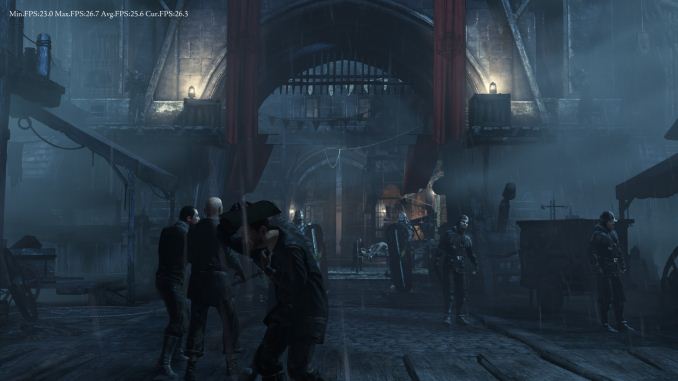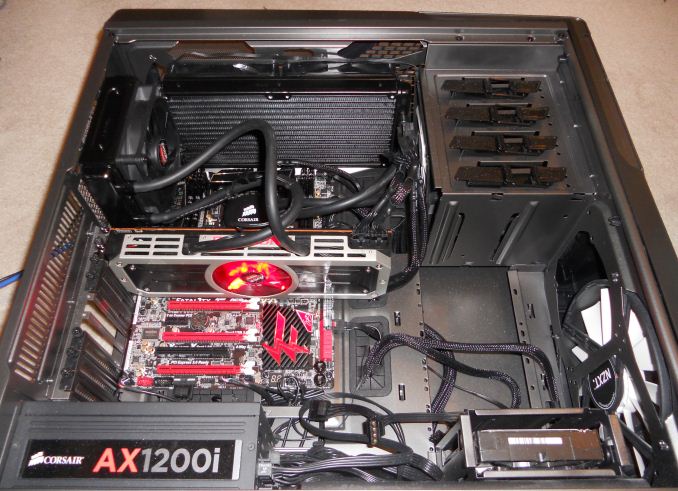The AMD Radeon R9 295X2 Review
by Ryan Smith on April 8, 2014 8:00 AM EST- Posted in
- GPUs
- AMD
- Radeon
- Radeon 200
The Test
Starting with today’s article we’ve made a small change to our suite of games. We are replacing our last 2012 game, Hitman: Absolution with another Square Enix title: the recently released Thief. Both games make use of many of the same graphical features, and both games include a built-in benchmark that is a good approximation of what a worst case rendering load in the game will behave like, making Thief a solid replacement for the older Hitman.
Meanwhile we’ve also updated all of our benchmark results to reflect the latest drivers from AMD and NVIDIA. For all AMD cards we are using AMD’s R9 295X2 launch drivers, Catalyst 14.4. Catalyst 14.4 appears to be a new branch of AMD’s drivers, given the version number 14.100, however we have found very few performance changes in our tests.
As for NVIDIA cards, we’re using the just-launched 337.50 drivers. These drivers contain a collection of performance improvements for NVIDIA cards and coincidentally come at just the right time for NVIDIA to counter AMD’s latest product launch.
We also need to quickly note that because AMD’s Radeon R9 295X2 uses an external 120mm radiator, we’ve had to modify our testbed to house the card. For our R9 295X2 tests we have pulled our testbed’s rear 140mm fan and replaced it with the R9 295X2 radiator. All other tests have the 140mm fan installed as normal.
| CPU: | Intel Core i7-4960X @ 4.2GHz |
| Motherboard: | ASRock Fatal1ty X79 Professional |
| Power Supply: | Corsair AX1200i |
| Hard Disk: | Samsung SSD 840 EVO (750GB) |
| Memory: | G.Skill RipjawZ DDR3-1866 4 x 8GB (9-10-9-26) |
| Case: | NZXT Phantom 630 Windowed Edition |
| Monitor: | Asus PQ321 |
| Video Cards: |
AMD Radeon R9 295X2 AMD Radeon R9 290X AMD Radeon R9 290 AMD Radeon HD 7990 AMD Radeon HD 6990 NVIDIA GeForce GTX Titan Black NVIDIA GeForce GTX 780 Ti NVIDIA GeForce GTX 780 NVIDIA GeForce GTX 690 NVIDIA GeForce GTX 590 |
| Video Drivers: |
NVIDIA Release 337.50 Beta AMD Catalyst 14.4 Beta |
| OS: | Windows 8.1 Pro |












131 Comments
View All Comments
CiccioB - Tuesday, April 8, 2014 - link
Well, not, not exactly. One thing is not being PCI compliant, and that's a thing I can understand. Another thing is going beyond connectors electrical power specifications. If they put 3 connectors I would have not had any problem. But as it is they are forcing components specifications, not simple indications rules on maximum size and power draw.meowmanjack - Tuesday, April 8, 2014 - link
If you look at the datasheet for the power connector (I'm guessing on the part number but the Molex part linked below should at least be similar enough), each pin is rated for 23 A and the housing can support a full load on each pin. Even if only 3 pairs are passing current, the connector can deliver over 800W at 12V.The limiting factor for how much power can be drawn from that connector is going to be the copper width and thickness on the PCB. If AMD designed the board to carry ~20 A (which the presumably have) off each connector it won't cause a problem.
meowmanjack - Tuesday, April 8, 2014 - link
Oops, forgot the datasheethttp://www.molex.com/molex/products/datasheet.jsp?...
behrouz - Tuesday, April 8, 2014 - link
Thanks For Link,Finally My Doubts were Resolved.Ian Cutress - Tuesday, April 8, 2014 - link
Most of the power will be coming from the PCIe power connectors, not the lane itself. If you have 5/6/7 in a single system, then yes you might start to see issues without the appropriate motherboard power connectors.dishayu - Tuesday, April 8, 2014 - link
I'm yet to read the review but FIVE HUNDRED WATTS? WOW!Pbryanw - Tuesday, April 8, 2014 - link
I'd be more impressed if it drew 1.21 Jigawatts!! :)krazyfrog - Tuesday, April 8, 2014 - link
On the second last page, the second last chart is of load GPU temperature when it should be load load noise levels.piroroadkill - Tuesday, April 8, 2014 - link
Reasonable load noise and temps, high performance. Nice.You'll want to get the most efficient PSU you can get your mitts on, though.
Also, I would seriously consider a system that is kicking out 600 Watts of heat to be something you wouldn't want in the same room as you. Your AC will work overtime, or you'll be sweating your ass off.
A GPU for Siberia! But then, that's not really a downside as such, just a side effect of having a ridiculous amount of power pushing at the edges of this process node.
Mondozai - Tuesday, April 8, 2014 - link
"Reasonable noise and temps"? It is shockingly quiet during load for a dual GPU card. And it has incredibly low GPU temps, too.As for heat, not really, only if you have a badly ventilated room in general or live in a warm climate.